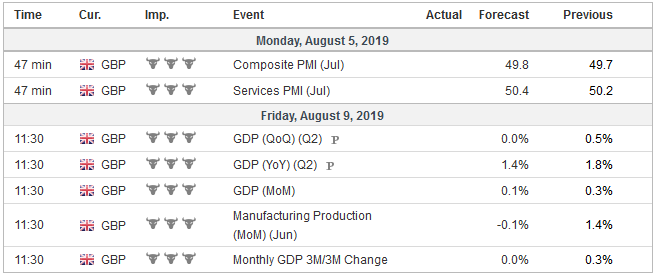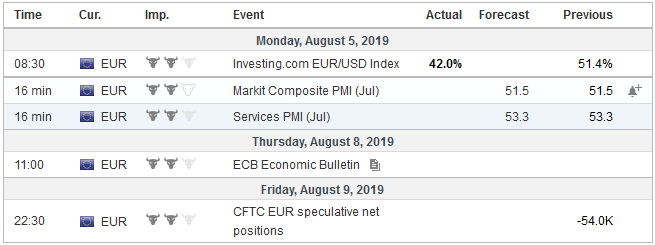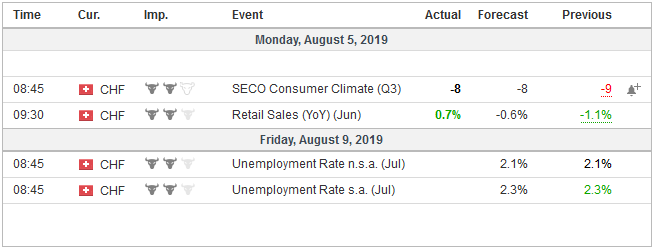The die is cast. To defend the uneven expansion and ward off disinflationary forces, monetary authorities will provide more accommodation. The Federal Reserve delivered its first rate cut in more than a decade and stopped unwinding its balance sheet two months earlier than it previously indicated (worth 0 bln of additional buying of Treasuries and Agencies). Following the end of the tariff truce, and after the July jobs report, the market was certain the Fed would cut rates again in September, according to Bloomberg and CME calculations). The ECB has signaled its intention to ease policy in September. It is also thought to be considering several different tools, including a deeper negative deposit rate, renewed
Topics:
Marc Chandler considers the following as important: 4.) Marc to Market, 4) FX Trends, Brexit, ECB, Featured, Federal Reserve, newsletter, trade, USD
This could be interesting, too:
Nachrichten Ticker - www.finanzen.ch writes Die Performance der Kryptowährungen in KW 9: Das hat sich bei Bitcoin, Ether & Co. getan
Nachrichten Ticker - www.finanzen.ch writes Wer verbirgt sich hinter der Ethereum-Technologie?
Martin Hartmann writes Eine Analyse nach den Lehren von Milton Friedman
Marc Chandler writes March 2025 Monthly
The die is cast. To defend the uneven expansion and ward off disinflationary forces, monetary authorities will provide more accommodation. The Federal Reserve delivered its first rate cut in more than a decade and stopped unwinding its balance sheet two months earlier than it previously indicated (worth $100 bln of additional buying of Treasuries and Agencies). Following the end of the tariff truce, and after the July jobs report, the market was certain the Fed would cut rates again in September, according to Bloomberg and CME calculations).
The ECB has signaled its intention to ease policy in September. It is also thought to be considering several different tools, including a deeper negative deposit rate, renewed asset purchases, and perhaps, easier terms for the TLTRO that will be forthcoming at the start of Q4.
The BOJ has downgraded its growth forecasts and acknowledges that it will not meet its inflation target for at least the next two years. It is unlikely to move until the after October when the impact of the sales tax increase can be assessed.
The US has lifted the debt ceiling and suspending spending caps. US fiscal policy is less restrictive, and there is talk that the Trump Administration will support efforts to index capital gains. UK government spending to prepare for a no-deal exit will increase, but it may prove insufficient to offset the private sector investment paralysis. Germany, it would seem from the outside, has the need and resources to expand fiscal policy (and funding at negative yields), but it lacks the will. On the other hand, Italy has the will but lacks the means. Japan can provide a supplemental budget if the sales tax increase makes it necessary.
Data from the first half no longer matters in terms of policy and even July data will have little impact. Before the central banks meet again, they will have a sense of how August is faring. The coming weeks have all the makings of the summer doldrums.
However, Trump’s declaration of new tariffs on China shifts the dynamics. Risks to world growth are greater. Interest rates will be lower for longer. The market may have been momentarily distracted by Powell’s comments during the press conference about the trajectory of Fed policy. The new tariffs prompted investors to lock in a third cut this year and price in about a one-in-four or one-in-five chance of a fourth cut, which would be one in each of the remaining FOMC meetings.
The next round of US-Chinese trade talks is slated for September after the new tariffs are to be implemented. Top Chinese leaders have their summer retreat in the first part of August. The policy response to the end of the tariff truce and the increased economic headwinds may be seen in late August or early September when the US tariffs are implemented. Chinese officials, who are blaming the US for the protests in Hong Kong, will likely use the approaching 70th anniversary of the Revolution (October 1) to play to the nationalist instincts. President Xi has used references to the Long March (when the Red Army had to evade the Kuomintang–Chinese Nationalist Army) to stir up nationalist sentiment.
b>The global risks and the impact already felt on US manufacturing and business investment that Fed Chairman Powell addressed at the press conference following the FOMC’s meeting, was a euphemism for US trade policy. Essentially, and without saying it so many words, Powell noted that the risk posed by the disruptions of trade, which is already having an impact, to the record-long expansion requires greater accommodation. Price pressures are undershooting, which gives the Fed that latitude to provide this accommodation and make an effort to avoid inflation expectations solidifying below target. And this does not even address the idea that the neutral rate of real interest rates (r*) may be lower than policymakers assume.
Within 24-hours of Powell’s explanation, and without warning, President Trump signaled the increase in Chinese tariffs and threatened to continue to ratchet them up until a deal is struck. The market had to price in not only the 10% increase on $300 bln of Chinese goods that had not been included in earlier actions but the risk of a further increase.
United StatesEconomic models seem to see the impact of trade conflict to be twice as much in China as it is on the US. The tariffs and counter-tariffs are thought to shave Chinese GDP by 0.4%-0.5% and the US by 0.2%-0.25%. The new actions could nearly double the impact. The final list of goods that will be hit in the new round is expected to be announced in the coming week or so. Until now, much of the tariffs have fallen on wholesale and intermediate goods that escape many consumers’ attention. Popular consumer electronic goods may be included in the tariff net. There is a relatively light economic diary next week for the US. The most important event maybe St. Loius Fed President Bullard comments on August 6. Bullard was the sole dissenter at the June meeting to stand pat, and by the end of July, a clear majority swung over. Before the recent data and trade actions, he suggested he was inclined to cut rates again before the end of the year. It appears that he won over a majority. The trade conflict with China dominates, but there is another major source of uncertainty: Europe. The risk of a no-deal Brexit may not be the Bank of England’s base case, but the market is taking it pretty seriously. Investors are voting with their pocketbook that the UK was stronger and its asset worth more when it is part of the EU. As sterling has slid a record 13 consecutive weeks against the euro, it has fallen to its lowest level since January 2017 against the dollar (~$1.2080). |
Economic Events: United States, Week August 05 |
United KingdomThe UK economy is expected to have stagnated in Q2 (reported August 9) after growing 0.5% in Q1. The third quarter is not off to a strong start, and the July Composite PMI likely remained below the 50 boom/bust level for the second consecutive month (reported August 5). Government spending may increase to demonstrate preparedness for leaving the EU at the end of October. To the extent that imports will be stockpiled, the stimulative impact of the fiscal support will be blunted. |
Economic Events: United Kingdom, Week August 05 |
EurozoneIt is not only Brexit but the eurozone itself that is a source of uncertainty. Consider that the German 30-year yield briefly traded below zero ahead of the weekend, putting the entire curve in negative territory briefly. The 10-year Bund yield finished the week at a new record low of negative 50 bp. The Swiss franc appreciated by a little more than 1% last week while its benchmark 10-year yield fell 12 bp previous week to a new low of minus 88 bp. The July composite eurozone PMI is expected to confirm the preliminary estimate of 51.5, down from 52.2 in June. Consider that the H1 19 average was 51.7 and 55.9 in H1 18. One need not go as far as some journalists did in suggesting the Fed is targeting the interest rate differential between the US and Europe to appreciate that negative rates in Europe and Japan ($14 trillion+) are impacting the financial conditions in the US. The eurozone is being forced to rely too much on monetary policy because the argument goes, Germany, the largest economy and can borrow for less than nothing, but doesn’t want to. This, in turn, is leaving the euro under-valued to the detriment of the US, the President says. Turning the formal announcement that the US secured a large share of Europe’s hormone-free beef imports quota may signal that the US will push out the confrontation with Europe. Perhaps the end of the truce with China commands the US focus. With the French digital tax, the German gas pipeline to Russia, the shortfall of NATO spending, the trade imbalance, there is much grist for the President’s mill. But that looks to hold for another day. |
Economic Events: Eurozone, Week August 05 |
Switzerland |
Economic Events: Switzerland, Week August 05 |
The central banks of Australia and New Zealand meet on August 6 and August 7, respectively. The RBA is expected to stand pat after cutting rates in June and July. Still, it is not the end of the easing cycle, though the market has downgraded the probability of a September decreased to about 44% from 54% at the end of last week. The cash rate currently stands at 1.00%, and the market is pricing about a 50% chance that it will be at or lower than 50 bp at the end of the year. The Australian dollar had fallen for 10 consecutive sessions before the weekend when Bloomberg says it was up a hundredth of a penny at $0.6801. It began the streak after the July 18 close of $0.7075. The move appears overdone in the short-term.
The Reserve Bank of New Zealand is set to cut its cash rate 25 bp to 1.25%. It cut rates in May. The market has priced in about a 70% chance that rate is 1.0% of lower at the end of the year. The New Zealand dollar has appreciated in one session of past 11. It was, according to Bloomberg, a hundredth of a penny gain on July 24 (to $0.6705). It began the run near $0.6785. The low for the year was set in May was about $0.6480. The New Zealand dollar may lag behind the Australian dollar in a correction that may be seen shortly.
Tags: #USD,Brexit,ECB,Featured,Federal Reserve,newsletter,Trade




